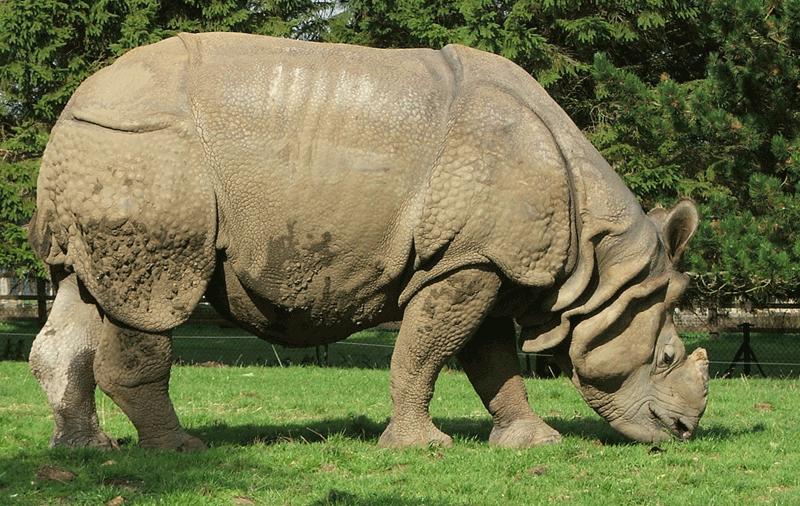|
| Query: White death | Result: 115th of 131 | |
Great One-horned Rhinoceros (Rhinoceros unicornis) - Wiki
| Subject: | Great One-horned Rhinoceros (Rhinoceros unicornis) - Wiki
| |

| Resolution: 800x506
File Size: 105869 Bytes
Upload Date: 2007:01:07 00:58:12
|
Indian Rhinoceros
From Wikipedia, the free encyclopedia
[Photo] Indian Rhinoceros at Whipsnade Zoo. Date 2006-09-04. Author: Alison Wheeler http://commons.wikimedia.org/wiki/User:AlisonW
The Indian Rhinoceros or the Great One-horned Rhinoceros (Rhinoceros unicornis) is a large mammal found in Nepal and in Assam, India. It is confined to the tall grasslands and forests in the foothills of the Himalayas. The Indian Rhinoceros can run as fast as 55 km/h for short periods of time and is also an excellent swimmer. It has an excellent sense of hearing and smell but relatively poor eyesight.
Anatomy
This prehistoric-looking rhinoceros has thick, silver-brown skin which creates huge folds all over its body. Its upper legs and shoulders are covered in wart-like bumps, and it has very little body hair. With size equal to that of the white rhino in Africa, it is the fourth-largest land animal, after the three elephant species. Fully grown males are larger than females in the wild, weighing from 2200 - 3000 kg (4,800 - 6,600 lb). The average height of the species is 1.70 m (5.7 feet) and the average length is 3.50 m (11.7 feet). The record-sized specimen of this rhino was approximately 3500 kg. The Great One-Horned Rhinoceros has a single horn; this is present in both males and females, but not on newborn young. The horn, like human fingernails, is pure keratin and starts to show after about one year. It reaches a length of between 20 and 61 cm.
Range
The rhino once inhabited areas from Pakistan to Burma and may have even roamed Myanmar and China. But because of human influence their range has shrunk and now they only exist in small populations in northeastern India and Nepal.
Behavior and Ecology
These rhinos live in tall grasslands and riverine forests, but due to habitat loss they have been forced into more cultivated land. They are mostly solitary creatures, with the exception of mothers and calves and breeding pairs, although they sometimes congregate at bathing areas. They have home ranges, the home ranges of males being usually 2-8 square kilometers in size, and overlapping each other. Dominant males tolerate males passing through their territory except when they are in mating season, when dangerous fights break out. They are active during the day and spend the middle of the day wallowing in lakes, rivers, ponds, and puddles to cool down. They are extremely good swimmers. Over 10 distinct vocalizations have been recorded.
The Indian Rhinoceros is a grazer. Their diet includes grasses, leaves, aquatic plants and fruits. Feeding occurs during the morning and evening where they use their prehensile lip to grasp grass stems.
Indian rhinos have few natural enemies, except for tigers. Tigers sometimes kill unguarded calves, but adult rhinos are less vulnerable due to their huge size and dangerous weapons. However, there is a recorded instance of a tiger killing a full-grown female Indian rhino.
Reproduction
Males can breed at nine years of age and females reach sexual maturity at five years and have their first calves when between six and eight years. The female whistles when in season so that males know when she is ready to mate. Fierce fights break out between males during the mating season. Unlike other rhinos they use their sharp lower teeth to fight and may sometimes end in death. The gestation period is about 16 months. Calves are weaned around 18 months. A single calf is born at intervals of about three years. Mother rhinos are attentive and protective, the young staying with the mother for several years. With the birth of a new young the female will chase off its older calve.
Population & Threats
This rhino is a major success of conservation. Only 100 remained in the early 1900's and now their population has increased but even so they are still endangered.
The Indian rhino is illegally poached for its horn, which some cultures in East Asia believe has healing and potency powers. Habitat loss is another threat. Fewer than 2500 individuals remain in the wild, and the species is endangered.
The Indian and Nepalese governments have taken major steps toward Indian Rhinoceros conservation with the help of the World Wildlife Fund (WWF). The Kaziranga National Park and Manas National Park in Assam and Royal Chitwan National Park in Nepal are homes for this endangered animal.
http://en.wikipedia.org/wiki/Indian_Rhinoceros
| The text in this page is based on the copyrighted Wikipedia article shown in above URL. It is used under the GNU Free Documentation License. You may redistribute it, verbatim or modified, providing that you comply with the terms of the GFDL. |
|
Comments |
|---|
| | Guest |
|
Indian rhinoceros (Rhinoceros unicornis)
Also known as: great Indian one-horned rhinoceros
Status: Classified as Endangered (EN ??? B1+2cde) on the IUCN Red List 2002 and listed on Appendix I of CITES.
The Indian rhinoceros is the largest of the Asian rhinos. It has a single horn, which can be as long as 53 cm and, like all rhino horns, is composed of keratin rather than bone. The skin is grey-brown and has many loose folds and tubercles, giving an armour-plated appearance. Indian rhinoceroses are often accompanied by ‘tick birds' (several species, including myna birds) and egrets that ride on their backs, and are thought to feed on parasites between the folds of skin. Egrets also forage on the insects exposed by the moving feet of the rhino. Males have large, sharp incisors that may be used in fights over females in the breeding season. |
^o^
Animal Pictures Archive for smart phones
^o^
|
|
|